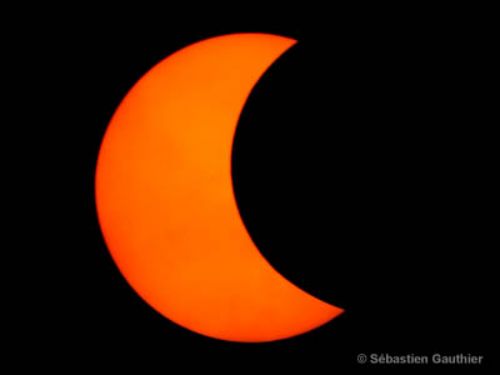Credit & Copyright: Sebastien Gauthier
Explanation:
Today the Sun reaches its southernmost
point
in planet Earth's sky at 13:37
UT.
This celestial event is known as a solstice, marking the beginning of
Summer in the
Southern Hemisphere and Winter in the North.
But this year, the solstice will be followed, on December 25th,
by another
geocentric
celestial event -- the last eclipse of the
millennium!
The Christmas day eclipse will only be a partial one
as
the silhouetted disk of the Moon obscures the Sun's edge.
Visible
from much of
Canada,
The United States and
Mexico, the appearance
of the partially eclipsed Sun might remind you of the
last holiday
cookie
you took a bite from.
Still, the exact timing and degree of the eclipse will depend
very much on your location.
This image,
from
an annular eclipse in 1994, shows the lunar disk
covering around 55% of the Sun's diameter.
It is representative of what could be seen from
Washington D. C. during the December 25 eclipse maximum
which, for that location, occurs at 12:41 PM ET.
As always, if you view the eclipse be
extremely careful to
protect your eyes.
1999 2000 2001 2002 2003 2004 2005 2006 2007 2008 2009 2010 2011 2012 2013 2014 2015 2016 2017 2018 2019 2020 2021 2022 2023 2024 2025 |
Yanvar' Fevral' Mart Aprel' Mai Iyun' Iyul' Avgust Sentyabr' Oktyabr' Noyabr' Dekabr' |
NASA Web Site Statements, Warnings, and Disclaimers
NASA Official: Jay Norris. Specific rights apply.
A service of: LHEA at NASA / GSFC
& Michigan Tech. U.
|
Publikacii s klyuchevymi slovami:
eclipse - solstice - partial solar eclipse - zatmenie - Solnce - solncestoyanie - chastnoe solnechnoe zatmenie - seasons
Publikacii so slovami: eclipse - solstice - partial solar eclipse - zatmenie - Solnce - solncestoyanie - chastnoe solnechnoe zatmenie - seasons | |
Sm. takzhe:
Vse publikacii na tu zhe temu >> | |
